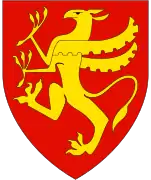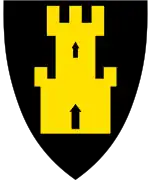Gáivuotna – Kåfjord – Kaivuono
Kåfjord (Norwegian), Gáivuotna [ˈkaːjːvuo̯tna] (Northern Sami), or Kaivuono (Kven)[3] is a municipality in Troms og Finnmark county, Norway. The administrative centre of the municipality is the village of Olderdalen. Other villages include Løkvollen, Manndalen, Birtavarre, Trollvik, Samuelsberg, Nordmannvik, and Djupvik.
Kåfjord kommune
Gáivuona suohkan Kaivuonon komuuni | |
|---|---|
 View of Olderdalen | |
 Flag 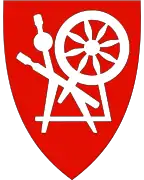 Coat of arms 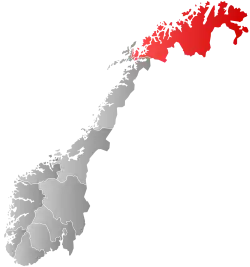 Troms og Finnmark within Norway | |
 Kåfjord within Troms og Finnmark | |
| Coordinates: 69°36′14″N 20°31′57″E | |
| Country | Norway |
| County | Troms og Finnmark |
| District | Nord-Troms |
| Established | 1929 |
| • Preceded by | Lyngen Municipality |
| Administrative centre | Olderdalen |
| Government | |
| • Mayor (2019) | Bernt Eirik Isaksen Lyngstad (Ap) |
| Area | |
| • Total | 991.14 km2 (382.68 sq mi) |
| • Land | 949.55 km2 (366.62 sq mi) |
| • Water | 41.59 km2 (16.06 sq mi) 4.2% |
| • Rank | #116 in Norway |
| Population (2022) | |
| • Total | 2,012 |
| • Rank | #278 in Norway |
| • Density | 2.1/km2 (5/sq mi) |
| • Change (10 years) | |
| Demonym | Kåfjording[1] |
| Official languages | |
| • Norwegian form | Bokmål |
| • Sámi form | Northern Sami |
| Time zone | UTC+01:00 (CET) |
| • Summer (DST) | UTC+02:00 (CEST) |
| ISO 3166 code | NO-5426 |
| Website | Official website |
The 991-square-kilometre (383 sq mi) municipality is the 116th largest by area out of the 356 municipalities in Norway. Kåfjord is the 278th most populous municipality in Norway with a population of 2,012. The municipality's population density is 2.1 inhabitants per square kilometre (5.4/sq mi) and its population has decreased by 9% over the previous 10-year period.[4][5]
General information
The municipality of Kåfjord was established in 1929 when the large Lyngen Municipality was divided into three: Lyngen in the northwest, Kåfjord in the northeast, and Storfjord Municipality in the south. The initial population of Kåfjord was 2,482. Then on 1 January 1992, the Nordnes area along the Lyngen fjord in Lyngen Municipality (population: 38) was transferred to Kåfjord Municipality.[6]
On 1 January 2020, the municipality became part of the newly formed Troms og Finnmark county. Previously, it had been part of the old Troms county.[7]
Name
The municipality (originally the parish) is named after the local Kåfjorden (Old Norse: Kofafjǫrðr). The name is likely a Norwegianized form of the Sámi name Gáivuotna. The first element of the Sami name has an unknown meaning. The last element is vuotna which means "fjord".[8]
The name of the municipality was simply Kåfjord from 1926 until 2 May 1994 when the name was changed to Gáivuotna–Kåfjord. This new name combined the Sami and Norwegian names into one.[6][9] It was the fifth municipality in Norway to get a Sami name. In 2005, the name was again changed such that either the Sami name (Gáivuotna) or the Norwegian name (Kåfjord) could be used interchangeably.[10]
In 2016, the name was changed again. This time, the Kven language name was added to the list of official names. All three names are equal and parallel names for the municipality. The official names of the municipality are Gáivuotna, Kåfjord, and Kaivuono, or more formally Gáivuona suohkan, Kåfjord kommune, and Kaivuonon komuuni.[11]
Coat of arms
The coat of arms was granted on 20 January 1989. The official blazon is "Gules, a spinning wheel argent" (Norwegian: I rødt en sølv rokk). This means the arms have a red field (background) and the charge is a spinning wheel. The spinning wheel has a tincture of argent which means it is commonly colored white, but if it is made out of metal, then silver is used. The spinning wheel was chosen because it is a timeless symbol. Handicrafts have long and particular traditions in Kåfjord. It is also a unifying symbol for Kåfjord's population since many residents (at the time of the adoption of the arms) had had a spinning wheel in their homes while they were growing up. It also is meant as a symbol of frugality, self-sufficiency, and an industrious people.[12][13][14] The arms were designed by Harald O. Lindbach.[15]
Churches
The Church of Norway has one parish (sokn) within the municipality. It is part of the Nord-Troms prosti (deanery) in the Diocese of Nord-Hålogaland.
| Parish (sokn) | Church name | Location of the church | Year built |
|---|---|---|---|
| Kåfjord | Kåfjord Church | Olderdalen | 1949 |
| Birtavarre Chapel | Birtavarre | 1937 |
History
In 1945, the villages of Kåfjord were burned to the ground during the retreat of German forces from Finland and Finnmark. This was as far west as the Wehrmacht used their scorched earth tactics.
Government
All municipalities in Norway, including Kåfjord, are responsible for primary education (through 10th grade), outpatient health services, senior citizen services, unemployment and other social services, zoning, economic development, and municipal roads. The municipality is governed by a municipal council of elected representatives, which in turn elect a mayor.[16] The municipality falls under the Nord-Troms District Court and the Hålogaland Court of Appeal.
Municipal council
The municipal council (Kommunestyre) of Kåfjord is made up of 17 representatives that are elected to four year terms. The party breakdown of the council is as follows:
| Party Name (in Norwegian) | Number of representatives | |
|---|---|---|
| Labour Party (Arbeiderpartiet) | 8 | |
| Progress Party (Fremskrittspartiet) | 1 | |
| Green Party (Miljøpartiet De Grønne) | 1 | |
| Conservative Party (Høyre) | 1 | |
| Christian Democratic Party (Kristelig Folkeparti) | 2 | |
| Centre Party (Senterpartiet) | 4 | |
| Total number of members: | 17 | |
| Party Name (in Norwegian) | Number of representatives | |
|---|---|---|
| Labour Party (Arbeiderpartiet) | 5 | |
| Progress Party (Fremskrittspartiet) | 1 | |
| Green Party (Miljøpartiet De Grønne) | 1 | |
| Conservative Party (Høyre) | 2 | |
| Christian Democratic Party (Kristelig Folkeparti) | 2 | |
| Centre Party (Senterpartiet) | 4 | |
| Manndalen, Skardalen, and Nordnes local list (Manndalen, Skardalen og Nordnes bygdeliste) | 2 | |
| Total number of members: | 17 | |
| Party Name (in Norwegian) | Number of representatives | |
|---|---|---|
| Labour Party (Arbeiderpartiet) | 8 | |
| Progress Party (Fremskrittspartiet) | 2 | |
| Christian Democratic Party (Kristelig Folkeparti) | 3 | |
| Coastal Party (Kystpartiet) | 1 | |
| Centre Party (Senterpartiet) | 2 | |
| Kåfjord local list (Kåfjord bygdeliste) | 1 | |
| Total number of members: | 17 | |
| Party Name (in Norwegian) | Number of representatives | |
|---|---|---|
| Labour Party (Arbeiderpartiet) | 10 | |
| Progress Party (Fremskrittspartiet) | 2 | |
| Christian Democratic Party (Kristelig Folkeparti) | 3 | |
| Centre Party (Senterpartiet) | 1 | |
| Socialist Left Party (Sosialistisk Venstreparti) | 1 | |
| Total number of members: | 17 | |
| Party Name (in Norwegian) | Number of representatives | |
|---|---|---|
| Labour Party (Arbeiderpartiet) | 6 | |
| Christian Democratic Party (Kristelig Folkeparti) | 3 | |
| Centre Party (Senterpartiet) | 1 | |
| Socialist Left Party (Sosialistisk Venstreparti) | 3 | |
| Outer Kåfjord local list (Ytre Kåfjord bydeliste) | 2 | |
| Inner Kåfjord local list (Indre Kåfjord bydeliste) | 2 | |
| Total number of members: | 17 | |
| Party Name (in Norwegian) | Number of representatives | |
|---|---|---|
| Labour Party (Arbeiderpartiet) | 4 | |
| Christian Democratic Party (Kristelig Folkeparti) | 3 | |
| Centre Party (Senterpartiet) | 2 | |
| Socialist Left Party (Sosialistisk Venstreparti) | 1 | |
| Outer Kåfjord local list (Ytre Kåfjord bydeliste) | 5 | |
| Inner Kåfjord local list (Indre Kåfjord bydeliste) | 2 | |
| Total number of members: | 17 | |
| Party Name (in Norwegian) | Number of representatives | |
|---|---|---|
| Labour Party (Arbeiderpartiet) | 5 | |
| Christian Democratic Party (Kristelig Folkeparti) | 5 | |
| Centre Party (Senterpartiet) | 2 | |
| Socialist Left Party (Sosialistisk Venstreparti) | 1 | |
| Outer Kåfjord local list (Ytre Kåfjord bydeliste) | 5 | |
| Inner Kåfjord local list (Indre Kåfjord bydeliste) | 3 | |
| Total number of members: | 21 | |
| Party Name (in Norwegian) | Number of representatives | |
|---|---|---|
| Labour Party (Arbeiderpartiet) | 6 | |
| Christian Democratic Party (Kristelig Folkeparti) | 2 | |
| Centre Party (Senterpartiet) | 2 | |
| Socialist Left Party (Sosialistisk Venstreparti) | 3 | |
| Outer Kåfjord local list (Ytre Kåfjord bydeliste) | 5 | |
| Inner Kåfjord local list (Indre Kåfjord bydeliste) | 2 | |
| Manndalen local list (Manndalen bygdeliste) | 1 | |
| Total number of members: | 21 | |
| Party Name (in Norwegian) | Number of representatives | |
|---|---|---|
| Labour Party (Arbeiderpartiet) | 7 | |
| Conservative Party (Høyre) | 1 | |
| Christian Democratic Party (Kristelig Folkeparti) | 2 | |
| Centre Party (Senterpartiet) | 1 | |
| Socialist Left Party (Sosialistisk Venstreparti) | 1 | |
| Outer Kåfjord local list (Ytre Kåfjord bydeliste) | 6 | |
| Inner Kåfjord local list (Indre Kåfjord bydeliste) | 1 | |
| Manndalen-Skardalen local list (Manndalen-Skardalen bygdeliste) | 2 | |
| Total number of members: | 21 | |
| Party Name (in Norwegian) | Number of representatives | |
|---|---|---|
| Labour Party (Arbeiderpartiet) | 9 | |
| Conservative Party (Høyre) | 1 | |
| Christian Democratic Party (Kristelig Folkeparti) | 4 | |
| Centre Party (Senterpartiet) | 2 | |
| Socialist Left Party (Sosialistisk Venstreparti) | 2 | |
| Outer Kåfjord local list (Ytre Kåfjord bydeliste) | 4 | |
| Inner Kåfjord local list (Indre Kåfjord bydeliste) | 1 | |
| Manndalen and Skardalen local list (Manndalen og Skardalen bygdeliste) | 1 | |
| Olderdalen local list (Olderdalen bygdeliste) | 1 | |
| Total number of members: | 25 | |
| Party Name (in Norwegian) | Number of representatives | |
|---|---|---|
| Labour Party (Arbeiderpartiet) | 9 | |
| Conservative Party (Høyre) | 2 | |
| Christian Democratic Party (Kristelig Folkeparti) | 5 | |
| Centre Party (Senterpartiet) | 2 | |
| Socialist Left Party (Sosialistisk Venstreparti) | 2 | |
| Outer Kåfjord local list (Ytre Kåfjord bydeliste) | 5 | |
| Total number of members: | 25 | |
| Party Name (in Norwegian) | Number of representatives | |
|---|---|---|
| Labour Party (Arbeiderpartiet) | 8 | |
| Christian Democratic Party (Kristelig Folkeparti) | 2 | |
| Centre Party (Senterpartiet) | 3 | |
| Socialist Left Party (Sosialistisk Venstreparti) | 3 | |
| Outer Kåfjord local list (Ytre Kåfjord bydeliste) | 3 | |
| Kåfjorddalen and Steinnes local list (Kåfjorddalen og Steinnes Bygdeliste) | 4 | |
| Manndalen and Skardalen local list (Manndalen og Skardalen bygdeliste) | 2 | |
| Total number of members: | 25 | |
| Party Name (in Norwegian) | Number of representatives | |
|---|---|---|
| Labour Party (Arbeiderpartiet) | 9 | |
| Centre Party (Senterpartiet) | 3 | |
| Socialist People's Party (Sosialistisk Folkeparti) | 2 | |
| Local List(s) (Lokale lister) | 11 | |
| Total number of members: | 25 | |
| Party Name (in Norwegian) | Number of representatives | |
|---|---|---|
| Labour Party (Arbeiderpartiet) | 10 | |
| Christian Democratic Party (Kristelig Folkeparti) | 1 | |
| Centre Party (Senterpartiet) | 3 | |
| Socialist People's Party (Sosialistisk Folkeparti) | 2 | |
| List of workers, fishermen, and small farmholders (Arbeidere, fiskere, småbrukere liste) | 5 | |
| Local List(s) (Lokale lister) | 4 | |
| Total number of members: | 25 | |
| Party Name (in Norwegian) | Number of representatives | |
|---|---|---|
| Labour Party (Arbeiderpartiet) | 9 | |
| Communist Party (Kommunistiske Parti) | 1 | |
| Local List(s) (Lokale lister) | 15 | |
| Total number of members: | 25 | |
| Party Name (in Norwegian) | Number of representatives | |
|---|---|---|
| Labour Party (Arbeiderpartiet) | 11 | |
| Communist Party (Kommunistiske Parti) | 1 | |
| List of workers, fishermen, and small farmholders (Arbeidere, fiskere, småbrukere liste) | 5 | |
| Local List(s) (Lokale lister) | 8 | |
| Total number of members: | 25 | |
| Party Name (in Norwegian) | Number of representatives | |
|---|---|---|
| Labour Party (Arbeiderpartiet) | 12 | |
| Communist Party (Kommunistiske Parti) | 4 | |
| Local List(s) (Lokale lister) | 9 | |
| Total number of members: | 25 | |
| Party Name (in Norwegian) | Number of representatives | |
|---|---|---|
| Labour Party (Arbeiderpartiet) | 14 | |
| Communist Party (Kommunistiske Parti) | 2 | |
| Liberal Party (Venstre) | 1 | |
| Local List(s) (Lokale lister) | 3 | |
| Total number of members: | 20 | |
| Party Name (in Norwegian) | Number of representatives | |
|---|---|---|
| Labour Party (Arbeiderpartiet) | 10 | |
| Communist Party (Kommunistiske Parti) | 1 | |
| List of workers, fishermen, and small farmholders (Arbeidere, fiskere, småbrukere liste) | 1 | |
| Joint List(s) of Non-Socialist Parties (Borgerlige Felleslister) | 3 | |
| Local List(s) (Lokale lister) | 5 | |
| Total number of members: | 20 | |
| Party Name (in Norwegian) | Number of representatives | |
|---|---|---|
| Labour Party (Arbeiderpartiet) | 6 | |
| Communist Party (Kommunistiske Parti) | 4 | |
| Local List(s) (Lokale lister) | 10 | |
| Total number of members: | 20 | |
| Party Name (in Norwegian) | Number of representatives | |
|---|---|---|
| Labour Party (Arbeiderpartiet) | 12 | |
| List of workers, fishermen, and small farmholders (Arbeidere, fiskere, småbrukere liste) | 5 | |
| Joint List(s) of Non-Socialist Parties (Borgerlige Felleslister) | 3 | |
| Total number of members: | 20 | |
| Note: Due to the German occupation of Norway during World War II, no elections were held for new municipal councils until after the war ended in 1945. | ||
Mayors
- 1930-1942: Anton D. Meedby (LL)
- 1942-1943: Leif Caroliussen (NS)
- 1943-1945: Edvard A. Manndal (NS)
- 1945-1946: Anton D. Meedby (LL)
- 1946-1959: Anton Antonsen (Ap)
- 1960-1963: Peder Sandbukt (Ap)
- 1964-1967: Andor Sandvoll (LL)
- 1968-1971: Hans Berg (Ap)
- 1972-1975: Halfdan Hansen (LL)
- 1976-1977: Peder Sandbukt (LL)
- 1978-1987: Einar Storslett (LL)
- 1988-1989: Ansgar Hansen (LL)
- 1990-1991: Einar Storslett (LL)
- 1991-1993: Terje Solberg (LL)
- 1993-1999: Åge B. Pedersen (Ap)
- 1999-2003: Kristin Vatnelid Johansen (LL)
- 2003–2015: Bjørn Inge Mo (Ap)
- 2015-2019: Svein O. Leiros (Sp)
- 2019–present: Bernt Eirik Isaksen Lyngstad (Ap)
Geography

The municipality is situated on the eastern side of the Lyngen fjord, and around its eastern arm, the Kåfjord. The municipal centre is Olderdalen. Other villages include Birtavarre, Kåfjorddalen, Djupvik, Nordmannvik, and Manndalen, where the international indigenous peoples' festival Riddu Riđđu is hosted each year.
On the border with Finland, is the mountain Ráisduattarháldi which has a height of 1,365 m (4,478 ft).
Economy
Fishing and small-scale farming have been the most important sources of income. Now many people work in education and other public services. The population has declined for many years, but the decline is now less rapid than earlier. A new optimism has arisen among young people, largely due to the increasing cultural activities.
Population
The majority of the population is of Sami origin. Due to assimilation pressure from the Norwegian State, the language was largely lost in the 20th century. Efforts are being made to reintroduce the Northern Sami language which is largely concentrated in the municipality's largest village, Manndalen/Olmmáivággi.
Notable people
- Erik Johnsen, (Norwegian Wiki) (1844 in Kåfjord i Lyngen – 1941) a Laestadian preacher, received the King's Medal of Merit (Kongens Fortjenstmedalje) in 1938 for his work for the salvation of the soul.[36]
- Rolf Ketil Bjørn (1938 in Kåfjord – 2008) a Norwegian businessperson and politician
- Jan Lindvall (born 1950 in Kåfjord) a Norwegian retired cross-country skier who competed at the 1984 Winter Olympics
Gallery
 Shed with green roof at Lyngen fjord
Shed with green roof at Lyngen fjord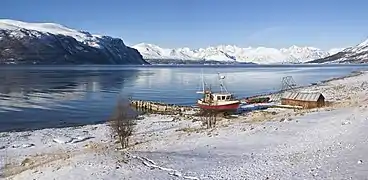 A view from the northeast coast of Kåfjorden
A view from the northeast coast of Kåfjorden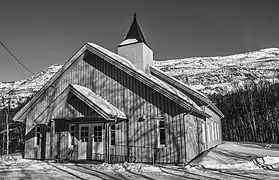 Fossheim
Fossheim
References
- "Navn på steder og personer: Innbyggjarnamn" (in Norwegian). Språkrådet.
- "Forskrift om målvedtak i kommunar og fylkeskommunar" (in Norwegian). Lovdata.no.
- "Stadnamn og rettskriving" (in Norwegian). Kartverket. Retrieved 13 July 2018.
- Statistisk sentralbyrå. "Table: 06913: Population 1 January and population changes during the calendar year (M)" (in Norwegian).
- Statistisk sentralbyrå. "09280: Area of land and fresh water (km²) (M)" (in Norwegian).
- Jukvam, Dag (1999). "Historisk oversikt over endringer i kommune- og fylkesinndelingen" (PDF) (in Norwegian). Statistisk sentralbyrå.
- Mæhlum, Lars, ed. (24 December 2019). "Troms og Finnmark". Store norske leksikon (in Norwegian). Kunnskapsforlaget. Retrieved 26 December 2019.
- Rygh, Oluf (1911). Norske gaardnavne: Tromsø amt (in Norwegian) (17 ed.). Kristiania, Norge: W. C. Fabritius & sønners bogtrikkeri. p. 152.
- "Ot.prp. nr. 111 (2001-2002)" (in Norwegian). regjeringen.no. 5 July 2002. Retrieved 2 December 2008.
- "Endring av skrivemåten for tospråklige kommunenavn" (in Norwegian). Archived from the original on 28 March 2014. Retrieved 2 December 2008.
- "Stadnamn og rettskriving" (in Norwegian). Statens kartverk. Retrieved 5 August 2018.
- "Civic heraldry of Norway - Norske Kommunevåpen". Heraldry of the World. Retrieved 26 January 2023.
- "Kåfjord, Troms (Norway)". Flags of the World. Retrieved 26 January 2023.
- "Godkjenning av våpen og flagg". Lovdata.no (in Norwegian). Norges kommunal- og arbeidsdepartementet. 17 March 1989. Retrieved 26 January 2023.
- W. Tengelsen, Torstein (31 October 1989). "Symbolet til India også Kåfjords" [Indian Symbol also Kåfjord's]. Framtid i Nord (in Norwegian Bokmål). Vol. 2, no. 80. p. 2.
- Hansen, Tore, ed. (12 May 2016). "kommunestyre". Store norske leksikon (in Norwegian). Kunnskapsforlaget. Retrieved 5 August 2018.
- "Tall for Norge: Kommunestyrevalg 2019 - Troms og Finnmark". Valg Direktoratet. Retrieved 24 October 2019.
- "Table: 04813: Members of the local councils, by party/electoral list at the Municipal Council election (M)" (in Norwegian). Statistics Norway.
- "Tall for Norge: Kommunestyrevalg 2011 - Troms Romsa". Valg Direktoratet. Retrieved 24 October 2019.
- "Kommunestyrevalget 1995" (PDF) (in Norwegian). Oslo-Kongsvinger: Statistisk sentralbyrå. 1996. Retrieved 18 March 2020.
- "Kommunestyrevalget 1991" (PDF) (in Norwegian). Oslo-Kongsvinger: Statistisk sentralbyrå. 1993. Retrieved 18 March 2020.
- "Kommunestyrevalget 1987" (PDF) (in Norwegian). Oslo-Kongsvinger: Statistisk sentralbyrå. 1988. Retrieved 18 March 2020.
- "Kommunestyrevalget 1983" (PDF) (in Norwegian). Oslo-Kongsvinger: Statistisk sentralbyrå. 1984. Retrieved 18 March 2020.
- "Kommunestyrevalget 1979" (PDF) (in Norwegian). Oslo: Statistisk sentralbyrå. 1979. Retrieved 18 March 2020.
- "Kommunevalgene 1975" (PDF) (in Norwegian). Oslo: Statistisk sentralbyrå. 1977. Retrieved 18 March 2020.
- "Kommunevalgene 1972" (PDF) (in Norwegian). Oslo: Statistisk sentralbyrå. 1973. Retrieved 18 March 2020.
- "Kommunevalgene 1967" (PDF) (in Norwegian). Oslo: Statistisk sentralbyrå. 1967. Retrieved 18 March 2020.
- "Kommunevalgene 1963" (PDF) (in Norwegian). Oslo: Statistisk sentralbyrå. 1964. Retrieved 18 March 2020.
- "Kommunevalgene og Ordførervalgene 1959" (PDF) (in Norwegian). Oslo: Statistisk sentralbyrå. 1960. Retrieved 18 March 2020.
- "Kommunevalgene og Ordførervalgene 1955" (PDF) (in Norwegian). Oslo: Statistisk sentralbyrå. 1957. Retrieved 18 March 2020.
- "Kommunevalgene og Ordførervalgene 1951" (PDF) (in Norwegian). Oslo: Statistisk sentralbyrå. 1952. Retrieved 18 March 2020.
- "Kommunevalgene og Ordførervalgene 1947" (PDF) (in Norwegian). Oslo: Statistisk sentralbyrå. 1948. Retrieved 18 March 2020.
- "Kommunevalgene og Ordførervalgene 1945" (PDF) (in Norwegian). Oslo: Statistisk sentralbyrå. 1947. Retrieved 18 March 2020.
- "Kommunevalgene og Ordførervalgene 1937" (PDF) (in Norwegian). Oslo: Statistisk sentralbyrå. 1938. Retrieved 18 March 2020.
- Lyngstad, Torleif (1991). Kåfjord - mennesker, administrasjon og politikk (in Norwegian). Kåfjord kommune. pp. 119–121, 184–185. ISBN 8299241707.
- "Biografi: Predikant Erik Johnsen, Manndalen". predikanterikjohnsenblog. 26 December 2013. Retrieved 5 August 2018.
External links
 The dictionary definition of Kåfjord at Wiktionary
The dictionary definition of Kåfjord at Wiktionary Troms travel guide from Wikivoyage
Troms travel guide from Wikivoyage- Municipal fact sheet from Statistics Norway (in Norwegian)

